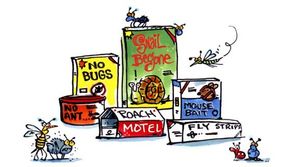
Synthetic pesticides are further grouped into similar chemical classes such as organochlorines, organophosphates,pyrethroids, and carbamates. Newer synthetic pesticides are more pest specific, exhibit lower toxicity and are less environmentally damaging. Organic pesticides such as rotenone, pyrethrum, nicotine, neem oil, and all of the botanical pesticides are products of living organisms, often used by them naturallu to protect themselves from parasites, predators and pathogens. Organic does not necessarily equal low toxicity and environmentally safer.
Inorganic pesticides - such as borates, silicates and sulfur, are minerals that work as poisons or by physically interfering with the pest. Older "inorganics" included such highly toxic compounds as arsenic, copper, lead and tin salts. Current inorganic pesticides suh as Borates: Bora Care and Timbor are relatively low in toxicity and have low environmental impact. Biorational pesticides - oils, insecticidal soaps, and microbials (such as Bacillus thurengienesis and entomopathogenic nematodes), botanicals (plant-based) and insect growth regulators have minimal impact on species for which they are not intended and exhibit lowest impact on the environment.
To delay the development of resistance, it's best to apply pesticides only when they are needed, by rotating between different chemical classes, and by using rates of pesticides within the labeled range. Integrating non-chemical approaches such as pheromone mating disruption and cultural controls can also help delay resistance.
Manage Turf Herbicide - selective herbicide used for the control of weed nutgrass - nutsedge (Purple Nutsedge, Yellow Nutsedge) and other weeds in turf grass and landscaped areas. Cool season grassess such as bluegrass and ryegrass are resistant. SedgeHammer replaces Manage herbicide by Monsanto, which Gowan Company acquired the rights. $18.00 for a 0.9 grams - one of the most expensive, but most effective. Ingredient: halosulfuron-methyl. practically non-toxic but caused decreased weight gain in rats and dogs.
LESCO® MANICURE® ULTRA Turf and Ornamental Fungicide. for Golf grass, used all over US. Ingredient: Tetrachloroisophthalonitrile. Toxic to fish. Chlorothalonil is a Group B2 "probable human carcinogen".
Mecomec® 4 Turf Herbicide provides effective control of listed broadleaf weeds in turfgrasses, including creeping bentgrass. tough broadleaf weeds, clover, plantain, ground ivy, and spurge. Top five crops and sites for this pesticide in California: Landscape Ornamental Turf Right of Way Structural Pest Control Greenhouse Flowers. MCPP-P, dimethylamine salt. Suspected of causing cancer
Medallion SC - to eradicate green algae. not a carcinogen
